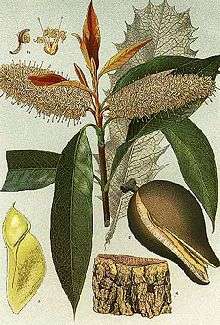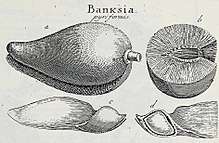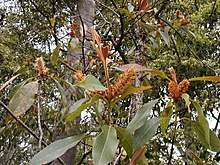Xylomelum
| Xylomelum | |
|---|---|
 | |
| Xylomelum pyriforme | |
| Scientific classification | |
| Kingdom: | Plantae |
| (unranked): | Angiosperms |
| (unranked): | Eudicots |
| Order: | Proteales |
| Family: | Proteaceae |
| Subfamily: | Grevilleoideae |
| Tribe: | Roupaleae |
| Subtribe: | Lambertiinae |
| Genus: | Xylomelum |
| Species | |
|
See text | |
Xylomelum is a genus of seven species in the plant family Proteaceae.[1] The name derives from the Greek xylon (wood) and melon (tree-fruit) (referencing the woody fruit).[2] They are native to Australia, growing in the form of tall shrubs and trees. The genus includes at least two species with the common name woody pear, Xylomelum pyriforme in the eastern states of Australia, and Xylomelum occidentale in Western Australia.
Two species, Xylomelum angustifolium and Xylomelum occidentale, are endemic to Western Australia[3] .[4] The remaining species are found in NSW and Queensland.[2]
A detailed description of Xylomelum is found at Flora of Australia online.
Species[1][5]
- Xylomelum angustifolium Kippist ex Meisn. J. Bot. Kew Gard. Misc. 4: 209 (1852)
- Xylomelum benthamii Orchard J. Adelaide Bot. Gard. 21: 89 (2007)
- Xylomelum cunninghamianum Foreman Muelleria 6: 299 (1987)
- Xylomelum occidentale R.Br. Suppl. Prodr. Fl. Nov. Holl.: 31 (1830)
- Xylomelum pyriforme (Gaertn.) Knight Cult. Prot.: 105 (1809) (Type species)
- Xylomelum salicinum A.Cunn. ex R.Br. Suppl. Prodr. Fl. Nov. Holl.: 31 (1830)
- Xylomelum scottianum (F.Muell.) F.Muell. Fragm. 5: 174 (1866)
Fruits
The fruits of Xylomelum are in the form of woody pears. When dried, these pears split down a central division, resulting in two halves. These "pears" are thought to have evolved primarily as a defense against seed predation. However, these woody fruits also provide protection of the seeds from fire. Johnson and Briggs (1963) consider the woody seeds in Proteaceae to be a late evolutionary adaptation to fire.[6]
Distribution
A map of the recorded occurrences of Xylomelum may be found at Australia's Virtual Herbarium.
Classification


In 1788, Joseph Gaertner described the type species of Xylomelum as Banksia pyriformis,[7] a species whose genus was effectively reclassified when Joseph Smith, in 1798, described the genus, Xylomelum, assigning it to the natural order Proteae of Jussieu.[8] Smith gave the essential characters of Xylomelum as: flower spikes with simple scales, flowers with four petals bearing four stamens, with a blunt, club-shaped stigma, with a uni-locular capsule having two seeds, the seeds being winged.[8]
In 1811, Robert Brown, in On the Proteaceae of Jussieu ,[9] gave a key to the genera of Proteaceae. The key places Xylomelum in the group of Proteaceae which have dehiscent fruit, and are unilocular with two seeds, thereby grouping Anadenia, Grevillea, Hakea, Lambertia, Orites and Rhopala together. Within the group, Xylomelum is distinguished from Orites and Rhopala by having winged seeds, a thickened woody follicle with an excentric locule, and a club-shaped stigma.[9]
Engler, in 1888,[10] divided the Proteaceae into two sub-families, Persoonioideae & Grevilloideae, placing Xylomelum in Grevilloideae, and as being like Helicia in having the flower axis at the base with four glands, but differing from it by having the inflorescence in 'ears', not in loose 'grapes', and by having seeds with wings.[10]
Within the Proteaceae, Johnson & Briggs (1975) placed Xylomelum in the subfamily Grevilleoideae and the tribe Heliciaea (together with Helicia, Triunia and Hollandaea).[11] However, Weston & Barker (2006),[12] argue that within the tribe of Roupaleae, Xylomelum should be placed in the subtribe of Lambertiinae and not together with the Helicia (in the subtribe of Heliciinae,[12] using in part, the evidence of the molecular studies of Hoot & Douglas,[13] who pair Xylomelum with Lambertia.[13]
See Grevilleoideae for further discussion of the placement of Xylomelum within the Proteaceae.
References
- 1 2 "Govaerts et al., Plants of the World online: Xylomelum". Retrieved 2018-03-16.
- 1 2 "Xylomelum". Flora of Australia Online: Data derived from Flora of Australia Volumes 16 (1995), 17A (2000) and 17B (1999). Australian Biological Resources Study (ABRS). Retrieved 2018-03-17.
- ↑ "Xylomelum angustifolium R.Br". FloraBase. Western Australian Government Department of Parks and Wildlife.
- ↑ "Xylomelum occidentale R.Br". FloraBase. Western Australian Government Department of Parks and Wildlife.
- ↑ "Australian Plant Name Index: Xylomelum pyriforme".
- ↑ Johnson, L.A.S. & Briggs, B.G. 1963. Evolution in the Proteaceae, Australian Journal of Botany, 11:21-61 Johnson, LAS; Briggs, BG (1963). "(DOI)". Australian Journal of Botany. 11: 21. doi:10.1071/BT9630021.
- ↑ Gaertner, J. 1788. De Fructibus et Seminibus Plantarum "Banksia pyriformis 1: 220,". "47, fig. 1".
- 1 2 Smith, J.E. 1798. The Characters of Twenty New Genera of Plants. Transactions of the Linnean Society of London 4: 214 "(BHL)". Retrieved 2018-03-17.
- 1 2 Brown,R. "On the Proteaceae of Jussieu". Proceedings of the Linnean Society 10:15-216.
- 1 2 "Proteaceae (pp. 119-156). In 'Die Natürlichen Pflanzenfamilien nebst ihren Gattungen und wichtigeren Arten, insbesondere den Nutzpflanzen, unter Mitwirkung zahlreicher hervorragender Fachgelehrten begründet.'". (Eds) A. Engler, K.A.E. Prantl, (W. Engelmann: Leipzig). Vol. 3(1).
- ↑ Johnson, L.A.S. & Briggs, B.G. 1975. On the Proteaceae-the evolution and classification, Botanical Journal of the Linnean Society 70(2): 83-182 Johnson, L. A. S; Briggs, Barbara G (1975). "(DOI)". Botanical Journal of the Linnean Society. 70 (2): 83. doi:10.1111/j.1095-8339.1975.tb01644.x.
- 1 2 Weston, Peter H.; Barker, Nigel P. (2006). "A new suprageneric classification of the Proteaceae, with an annotated checklist of genera" (PDF). Telopea. 11 (3): 314–344.
- 1 2 Hoot, S.B. and Douglas, A.W. 1998. Phylogeny of Proteaceae based on atpB and atpB-rbcL intergenic spacer region sequences. Australian Systematic Botany 11: 301-320 Hoot, Sara B; Douglas, Andrew W (1998). "(DOI)". Australian Systematic Botany. 11 (4): 301. doi:10.1071/SB98027.
| Wikispecies has information related to Xylomelum |
| Wikimedia Commons has media related to Xylomelum. |